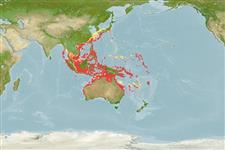Environment: milieu / climate zone / depth range / distribution range
Ecología
marino bentopelágico; rango de profundidad 1 - 78 m (Ref. 11897). Tropical; 38°N - 31°S, 90°E - 179°E
Eastern Indian Ocean and Western Pacific: Andaman Sea to Fiji, north to Japan, south to Australia. Replaced by Ablabys binotatus in the western Indian Ocean (Ref. 9710).
Tamaño / Peso / Age
Maturity: Lm ? range ? - ? cm
Max length : 15.0 cm TL macho / no sexado; (Ref. 48635)
Espinas dorsales (total) : 17 - 18; Radios blandos dorsales (total) : 6 - 7; Espinas anales: 3; Radios blandos anales: 4 - 5.
Inhabits shallow, subtidal areas with sand rubble and weed (Ref. 9710). A strongly compressed fish that can be seen rocking back and forth on the bottom in response to surge. Easily caught with small hand nets. Nocturnal (Ref. 48635). Solitary or in pairs (Ref 90102).
Life cycle and mating behavior
Madurez | Reproducción | Puesta | Huevos | Fecundidad | Larva
Randall, J.E., G.R. Allen and R.C. Steene, 1990. Fishes of the Great Barrier Reef and Coral Sea. University of Hawaii Press, Honolulu, Hawaii. 506 p. (Ref. 2334)
IUCN Red List Status (Ref. 130435: Version 2024-2)
Threat to humans
Venomous
Human uses
Pesquerías: comercial; Acuario: Comercial
Herramientas
Special reports
Download XML
Fuentes de Internet
Estimates based on models
Preferred temperature (Ref.
123201): 23.5 - 29, mean 28.1 °C (based on 1122 cells).
Phylogenetic diversity index (Ref.
82804): PD
50 = 0.6250 [Uniqueness, from 0.5 = low to 2.0 = high].
Bayesian length-weight: a=0.01905 (0.00776 - 0.04678), b=3.03 (2.82 - 3.24), in cm total length, based on LWR estimates for this (Sub)family-body shape (Ref.
93245).
Nivel trófico (Ref.
69278): 3.2 ±0.3 se; based on size and trophs of closest relatives
Resiliencia (Ref.
120179): Medio, población duplicada en un tiempo mínimo de 1.4-4.4 años (Preliminary K or Fecundity.).
Fishing Vulnerability (Ref.
59153): Low vulnerability (10 of 100).
Nutrients (Ref.
124155): Calcium = 158 [70, 338] mg/100g; Iron = 0.965 [0.445, 2.055] mg/100g; Protein = 15.9 [14.3, 17.5] %; Omega3 = 0.275 [0.103, 0.851] g/100g; Selenium = 51.1 [22.6, 131.7] μg/100g; VitaminA = 46 [12, 187] μg/100g; Zinc = 1.57 [0.99, 2.44] mg/100g (wet weight);
